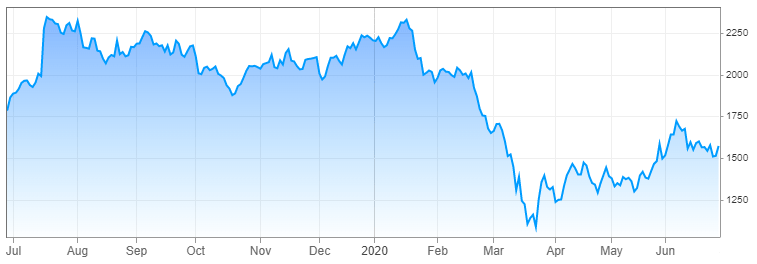Burberry Shares Rise by 4%, Despite Threats of US Tariffs

As markets opened on Friday on the London exchange, the Burberry PLC shares have made some steady gains and jumped by 4%. The stock previously closed at 1,512p, yet after the recent move has risen to 1,571p.
This development might be surprising for many investors since the US government has recently announced plans to impose an additional $3.1 billion worth of tariffs on imports coming from the United Kingdom and European Union countries. During the previous year, the Trump administration has already imposed a $7.5 billion worth of tariffs on EU imports.
Those policies can create significant problems for companies like Burberry PLC, which export significant portions of their merchandise abroad. Tariffs do make imported goods much more expensive. As a result, the US consumer will be more likely to purchase local produce, which might be cheaper than those goods mentioned above. As a result, Burberry PLC and many other UK and EU companies will most likely see their sales decline in the United States. This in turn can cause a loss of revenue and threaten the long term profitability of those businesses.
Obviously, imposing tariffs do have its advantages and disadvantages as well. On the positive side, it might help US businesses to boost local sales and the Federal government can increase its income by higher tax revenues.
However, on the downside, this process makes imported products more expensive and can lead to higher inflation rates in the long term. Also, it is likely that at some point the United Kingdom and the European Union will impose their retaliatory tariffs, which in turn can hurt the sales of US businesses in those regions.
Why is Burberry Stock Rising Despite those Threats?
Considering all those arguments, it is highly surprising that the Burberry stock is still making some gains. The first possible reason is the fact that over the years the company has achieved a significant geographic diversification in terms of its sales. According to the official investor pocketbook, which the firm released in May 2020, only 23% of its revenues come from the Americas.
Here it is worth mentioning that this category includes not only the US but also other countries in the continent, such as Mexico and Canada. Therefore, the company’s exposure to the United States market might be close to 15%. So the negative impact of those tariffs might not be as devastating for the company as one might think.
The second possible reason for this resilience is the fact that Burberry PLC specializes in luxury products, which is always connected to building brand loyalty. When it comes to those types of merchandise, they are what the economists call ‘price inelastic’.
This might seem quite a complicated term, but the basic idea behind price elasticity is very simple. It measures how consumers respond to price changes. So if a product became more expensive and customers buy less of those, because of that, then it is price elastic.
So when it comes to luxury brands the opposite is the case. People who buy those products are highly likely to still purchase those on a regular basis, regardless of any price changes. For many individuals, they represent status symbols in society. Therefore, it is highly unlikely that they would stop buying those brands, just because they became slightly more expensive due to recent tariffs.
The final reason for this type of reaction from Burberry stock price is the fact that it is not clear whether this type of protectionist policy will persist in the US. 2020 is an election year in the country, so until November it will not be clear whether the current administration will be able to maintain power.
Therefore there is always a possibility that if a new government changes due to election, the new leaders might reverse those policies and return to free trade. That possibility is already being discussed by US politicians on many occasions. If that was the case, then things can certainly return to normal and European companies might avoid the loss of revenue. Consequently, it might be still too early to be pessimistic about the future prospects of Burberry PLC and other UK companies.
Share Price Performance of Burberry PLC

source: cnbc.com
As we can see from the chart above, by the end of June 2020, the shares were trading at 1,780p. The stock has made some notable gains in July of that year, eventually rising to 2,250p. At this stage, the shares have settled for range trading for several months, without any dramatic changes during this period.
The Burberry stock fell victim to the March 2020 stock market crash. As a result of this even shares have dropped from 2,000p to 1,085p by late March. At this point the share price stabilized and then recovered, eventually reaching 1,571p.
According to CNBC, the latest Earnings per Share (EPS) indicator of the firm stands at 29.80p. This means that at current rates, the Price to Earnings ratio of the stock is near 52.7. This suggests that the stock is significantly overpriced and might not have much potential for capital appreciation.
Before the outbreak of the COVID-19 pandemic, the total annual dividend of the company had amounted to 42.8p per share. However, in May 2020 the company decided to temporarily cancel those payouts to shareholders. Currently, it seems obvious that the firm will not be making any payments to shareholders. Yet, if they reinstate those payouts from the next year, then at current prices, the dividend yield will be around 2.7%.
This suggests that this stock can not be an obvious choice for income investors. At this stage, it is not yet clear whether the management will be in a position to restore dividend payments in 2021. So when it comes to income investing, currency there are far more reliable options with very decent dividend yields in the marketplace.


























Comments (0 comment(s))